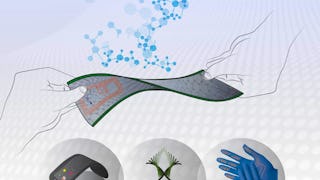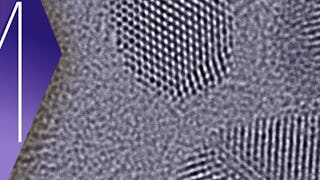How can we create nano-structures that are 10,000 times smaller than the diameter of a human hair? How can we “see” at the nano-scale? Through instruction and lab demonstrations, in this course you will obtain a rich understanding of the capabilities of nanotechnology tools, and how to use this equipment for nano-scale fabrication and characterization. The nanoscale is the next frontier of the Maker culture, where designs become reality. To become a Nanotechnology Maker pioneer, we will introduce you to the practical knowledge, skills, and tools that can turn your nanotechnology ideas into physical form and that enable you to image objects at the nano-scale.




(3,108 reviews)
Skills you'll gain
Details to know

Add to your LinkedIn profile
30 assignments
See how employees at top companies are mastering in-demand skills

There are 9 modules in this course
Welcome to Nanotechnology! In this module, you will learn some of the basics of nanofabrication and nanocharacterization techniques as well as specific applications of nanotechnology in commercial products. You’ll be able to explain why a cleanroom and vacuum environment are necessary for creating nanotechnology products. Finally, you will be able to explain how we use light, x-rays, and electron beams to characterize objects at the nanoscale. For more detailed learning objectives for each video, please see the first reading.
What's included
10 videos4 readings3 assignments
After this module, you will be able to explain sample preparation and imaging techniques used in scanning electron microscopy. You will also be able to explain the benefits of environmental scanning electron microscopy. Furthermore, you will discover how energy-dispersive x-ray spectroscopy can be paired with scanning electron microscopy to gain elemental information about samples.
What's included
8 videos3 readings3 assignments
In this module, we will look at transmission electron microscopy and cryo-transmission electron microscopy. You will learn to describe the basic function of the equipment as well as how samples are prepared and imaged using these techniques.
What's included
7 videos3 readings3 assignments
In this module, we will see demonstrations of micro-computed tomography, X-ray photoelectron spectroscopy, and optical spectroscopy. You will learn the basic function of the equipment and how samples are prepared and measured.
What's included
11 videos4 readings4 assignments
In this module, we will discover how and why a vacuum environment is required in nanofabrication, compare the operation of three types of vacuum pumps, and look at vacuum deposition of thin films using three different methods: sputter evaporation, e-beam evaporation and thermal evaporation.
What's included
11 videos3 readings3 assignments
We will look at some techniques for making things with nanotechnology using thin film techniques; in this module you will learn to describe and compare atomic layer deposition, chemical vapor deposition, and plasma-enhanced chemical vapor deposition.
What's included
8 videos4 readings4 assignments
In this module, we will investigate 5 different methods used in nanotechnology for patterning. You will be able to explain the basic processes of photolithography, e-beam lithography, ion beam lithography, hot embossing, and self-assembly.
What's included
11 videos6 readings6 assignments
In this module, you will learn to describe and compare wet and dry etching processes. These processes are used to selectively remove material in nanofabrication.
What's included
7 videos4 readings4 assignments
What's included
1 video1 reading
Instructors



Explore more from Electrical Engineering
 Status: Preview
Status: PreviewTechnion - Israel Institute of Technology
 Status: Preview
Status: PreviewTechnion - Israel Institute of Technology
 Status: Free Trial
Status: Free TrialUniversity of Minnesota
 Status: Preview
Status: PreviewÉcole Polytechnique Fédérale de Lausanne
Why people choose Coursera for their career




Learner reviews
3,108 reviews
- 5 stars
84.24%
- 4 stars
14.14%
- 3 stars
1.31%
- 2 stars
0.16%
- 1 star
0.12%
Showing 3 of 3108
Reviewed on Feb 18, 2022
English language training to know quantum motion and quantum energies
Reviewed on Jul 13, 2020
Prof. Nan Jokerst is an outstanding faculty. She made this course interesting and outstanding among all other faculties. Thank You so Much Prof. Nan Jokerst Making Nanotechnology Interesting course.
Reviewed on Mar 6, 2020
I am very glad and much satisfied to complete this course. Actullay at this time i am not able to purchase cetificate due to financail issues but i am glad to learn much from this course.

Open new doors with Coursera Plus
Unlimited access to 10,000+ world-class courses, hands-on projects, and job-ready certificate programs - all included in your subscription
Advance your career with an online degree
Earn a degree from world-class universities - 100% online
Join over 3,400 global companies that choose Coursera for Business
Upskill your employees to excel in the digital economy
Frequently asked questions
Learners will need to have taken a course in high school (secondary school) physics or chemistry
No. Completion of a Coursera course does not earn you academic credit from Duke; therefore, Duke is not able to provide you with a university transcript. However, your electronic Certificate will be added to your Accomplishments page - from there, you can print your Certificate or add it to your LinkedIn profile.
To access the course materials, assignments and to earn a Certificate, you will need to purchase the Certificate experience when you enroll in a course. You can try a Free Trial instead, or apply for Financial Aid. The course may offer 'Full Course, No Certificate' instead. This option lets you see all course materials, submit required assessments, and get a final grade. This also means that you will not be able to purchase a Certificate experience.
More questions
Financial aid available,






